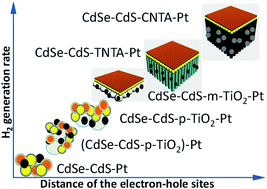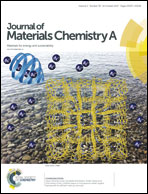Fabricating efficient CdSe–CdS photocatalyst systems by spatially resetting water splitting sites†
Abstract
Water oxidation and reduction over semiconductor-based photocatalysts intrinsically occur at different spatial sites. Modulation of the reaction sites and charge transfer between them are logically important in speeding up the reaction. Here, we demonstrate that divorcing a CdSe–CdS–Pt donor–acceptor system on different surface sites of TiO2 can significantly increase the H2 generation rate. The increase is derived from an effective reset of water oxidation and reduction sites. Widening of the site distance by employing a TiO2 membraniform acceptor effectively decreases the electron–hole recombination especially for a membrane of TiO2 nanotube arrays. The oriented charge transfer characteristic of TiO2 nanotube arrays benefits long-range electron transport, thereby increasing the electron lifetime and reaction rate. When more conductive carbon nanotube arrays serve as an electron acceptor to replace TiO2, the electron transport is greatly improved, resulting in an ultrahigh H2 generation rate of 1270 mmol g−1 h−1. This work provides a basis for the design and construction of highly efficient photocatalysts through rational modulation of reaction sites and charge transport.



 Please wait while we load your content...
Please wait while we load your content...